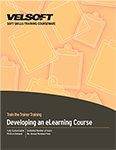Course outline for
Developing an eLearning Course
Developing an eLearning Course Course Outline

Session One: Course Overview
Course Overview
Learning Objectives
Pre-Assignment
Pre-Course Assessment
Session Two: Instructional Design Models
Instructional Design Models
ADDIE
Backward Design
Merrill's framework incorporates five principles of learning:
Instructional Design Model
Elements of an eLearning Development Process
Session Three: Analysis Phase - Needs Assessment
Business Goals
Business Goals Activity
Needs Assessment
Training Needs Activity
Session Four: Design Phase - Learning Objectives
Writing Learning Objectives
BLOOM
Measurable Objectives
Writing Learning Objectives
Session Five: Design Phase - Assessment
Assessment
Developing Assessments for eLearning
Types of eLearning Assessments
Rubrics
Creating Rubrics
Session Six: Design Phase - Reducing Barriers
Universal Design
Activities for Universal Design Learning
UDL and LGBTQ2+
Activities for Universal Design Learning
Session Seven: Design Phase - Accessibility
Accessibility
Web Content Accessibility Guidelines (WCAG) Checklist
Applications and Software
Functional Performance Criteria
Accessibility Activity
Session Eight: Design Phase - Design Strategy
Design Strategy
Development Time
User Interface
Design Options
Deciding Media Standards
Session Nine: Development Phase - Learning Experiences and Instruction
Teaching Adults
Ways of Teaching Children vs Adults
Best Practices of Adult Educational Methodologies
Tenets of Adult Education
Creating an Outline, Gathering Content and Developing a Storyboard
Production
Session Ten: Development Phase - eLearning Tools
Selecting eLearning Authoring tools
Selecting a Learning Management System
Session Eleven: Evaluation
Kirkpatrick's Levels of Evaluation
Personal Action Plan
Course Summary
Recommended Reading List
Post-Course Assessment
Pre- and Post-Course Assessment Answer Key
Pre-Course Assessment
Post-Course Assessment
Assignment Answer Key
Session Two: Instructional Design Models
Session Three: Analysis Phase - Needs Assessment
Session Four: Design Phase - Learning Objectives
Session Five: Design Phase - Assessment
Session Six: Design Phase - Reducing Barriers
Session Seven: Design Phase - Accessibility
Session Eight: Design Phase - Design Strategy
Session Nine: Development Phase - Learning Experiences and Instruction
Download this course as a demo
Complete the form below and we'll email you an evaluation copy of this course:
Video
More Course Outlines in this Series
- Facilitation Skills
- Survival Skills for the New Trainer
- The Practical Trainer
- Using Activities to Make Training Fun
- Making Training Stick
- Training with Visual Storytelling
- Developing a Training Needs Analysis
- Measuring Training Results
- Developing an eLearning Course
- Mastering Adult Learning Methods
- Exploring Universal Design for Learning
- Developing a Lunch and Learn Program
- Enhanced Learning Experiences with UDL
- Advanced Skills for the Practical Trainer
- Developing a Training Program
